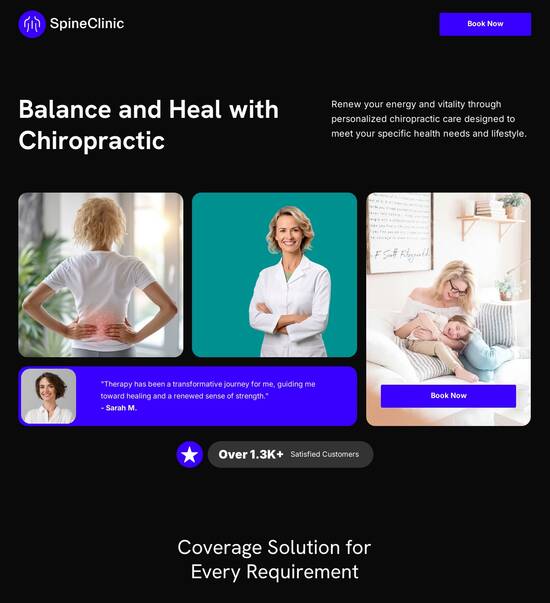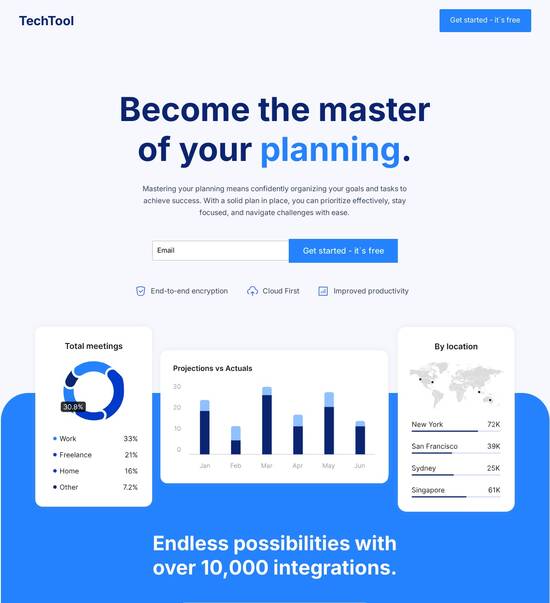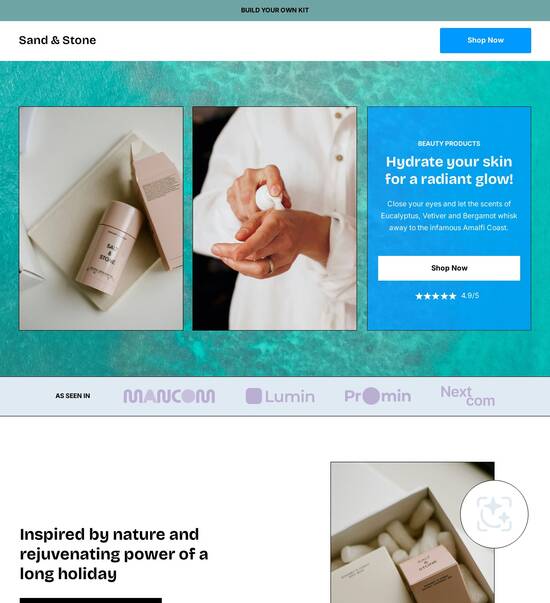
Bootstrap optimized sitemap page template
Explore Similar TemplatesAbout template
Supercharge your sitemap page with Bootstrap for outstanding performance! Learn more today.
Recommended templates

Easy to build without coding
With the intuitive drag-and-drop builder, anyone on your team can create high-converting pages without any knowledge of code or design. Make enhancements to your landing page with custom widgets using Javascript, HTML/CSS, or third-party scripts.

Multiple layouts for any industry and goal
Select from 500+ landing page layouts built to boost conversions across industry-specific scenarios. Customize them by adjusting fonts, adding images, and generating on-brand content with the AI assistant. Quickly scale with Instablocks® and Global Blocks that you can save, reuse, and update globally.

Loads fast and looks polished on any device
Every template is responsive, which means they present professionally on any device and load blazingly fast with our Thor Render Engine. You can also power them up with Google AMP technology to deliver an unparalleled mobile experience and drive higher conversions.

Robust analytics & experimentation
Get real-time updates and reporting across all your devices, showing the number of visitors, conversions, cost-per-visitor, and cost-per-lead. Launch AI-powered experiments, run A/B tests, and use heatmaps to analyze user behavior, then optimize your landing page to maximize conversions.







Easy to build without coding
With the intuitive drag-and-drop builder, anyone on your team can create high-converting pages without any knowledge of code or design. Make enhancements to your landing page with custom widgets using Javascript, HTML/CSS, or third-party scripts.
Multiple layouts for any industry and goal
Select from 500+ landing page layouts built to boost conversions across industry-specific scenarios. Customize them by adjusting fonts, adding images, and generating on-brand content with the AI assistant. Quickly scale with Instablocks® and Global Blocks that you can save, reuse, and update globally.
Loads fast and looks polished on any device
Every template is responsive, which means they present professionally on any device and load blazingly fast with our Thor Render Engine.
Robust analytics & experimentation
Get real-time updates and reporting across all your devices, showing the number of visitors, conversions, cost-per-visitor, and cost-per-lead. Launch AI-powered experiments, run A/B tests, and use heatmaps to analyze user behavior, then optimize your landing page to maximize conversions.
All the features you need to build sitemap html template
Explore more featuresLearn how to build top-performing landing pages for any goal
FAQs
Leading the way in building high-performing landing pages





A powerful guide to the Instapage landing page and CRO platform
Instapage is the most robust landing page and conversion rate optimization (CRO) platform available, designed to empower marketers in the USA across various verticals such as business services, education, and tech. This step-by-step guide will help you optimize, accelerate, and scale your digital marketing campaigns effectively.
Understanding the importance of optimized landing pages
Creating effective landing pages starts with understanding user behavior. Instapage provides a suite of tools allowing you to craft pages that not only draw in traffic but also convert visitors into leads and customers. The built-in analytics and optimization features enable marketers to iterate quickly based on real-time data.
- High-converting templates: With over 100 ready-to-use templates, Instapage streamlines the process of setting up landing pages that capture attention and generate leads.
- A/B testing: Compare different versions of your landing pages to discover which elements drive better results.
- Heatmaps: Visualize user interactions to identify which areas of your page attract the most engagement.
Step 1: Design your landing page
The first step in creating a landing page is focusing on the design. Here's how you can utilize Instapage's features to build an engaging page:
- Use templates: Start with a high-converting template to save time and resources while ensuring professional results.
- Integrate lead generation elements: Include forms and call-to-action buttons to guide users toward conversion.
- Personalize content: Use dynamic text replacement features to tailor the content specifically to different audience segments.
Step 2: Optimize and test your landing page
Next, focus on optimization to maximize conversions. You'll need to incorporate several strategies:
- Conduct A/B tests: Regularly test different elements such as headlines and images to see what resonates best with your audience.
- Utilize data analytics: Review performance reports to understand visitor behavior and adjust your strategy accordingly.
- Implement targeting options: Use AdMaps to align specific ads with targeted landing pages for a cohesive user experience.
Step 3: Collaborate for success
Collaboration is key to refining your campaigns. Leverage Instapage's collaborative tools to enhance productivity:
- Real-time feedback: Share pages with team members or stakeholders and gather insights instantly.
- Edit together: Collaborators can work on pages in real-time, making changes and suggestions as needed.
- Version control: Keep track of edits and revisions easily, ensuring everyone is on the same page.
With these steps, you’ll be well on your way to maximizing the performance of your marketing campaigns using Instapage.
Ready to start optimizing your landing pages? Sign up for Instapage today and take advantage of powerful tools tailored to elevate your marketing efforts.
Bootstrap optimized sitemap page template
Understanding Bootstrap: A framework for responsive design
Bootstrap is a leading front-end framework developed to create responsive websites. Since its introduction, it has continually evolved, becoming a go-to solution for developers seeking to build user-friendly and visually appealing web pages. The relevance of Bootstrap in modern web development cannot be overstated; it allows developers to save time and resources by providing pre-styled components and a systematic approach to building layouts.
Utilizing Bootstrap helps streamline the design process, enabling teams to focus on functionality rather than starting from scratch. This framework is widely recognized for its ability to facilitate smooth user experiences across all devices and screen sizes, addressing the diverse landscape of devices accessed by users today.
Responsive grid system that adapts layouts based on device size.
Predefined components such as buttons, forms, and navigation bars.
Utility classes for customizing styles without writing CSS from scratch.
The importance of sitemaps for websites
A sitemap is fundamentally a map or blueprint of your website, essentially serving as a guide for both users and search engines. It helps outline how different pages and sections of the website are organized and interconnected. There are two primary types of sitemaps: XML sitemaps, which are geared towards search engines and focused on optimizing crawling and indexing, and HTML sitemaps designed primarily for users, improving navigation and accessibility.
Implementing a sitemap can significantly enhance your website's visibility in search engines. By providing a structured layout, sitemaps ensure that website crawlers can efficiently explore and understand the site's architecture, which ultimately leads to better indexing. The benefits extend further as sitemaps can reduce bounce rates by facilitating user navigation, ensuring visitors find the information they need quickly.
Enhances website visibility through structured layouts.
Facilitates crawling by providing clear paths for search engines.
Improves indexing efficiency, leading to better search rankings.
Building a Bootstrap optimized sitemap page template
Choosing a Bootstrap sitemap page template offers immense advantages, particularly for websites that have already adopted Bootstrap for their overall design. These templates ensure seamless integration and maintain the continuity of the user interface. Moreover, as users interact with your site on various devices, a Bootstrap sitemap template guarantees responsive behavior, offering an optimal viewing experience across desktops, tablets, and smartphones.
Bootstrap templates are also highly customizable, allowing business owners to tailor their sitemaps to align with branding styles and user preferences. By using pre-designed components, creating an attractive and functional sitemap becomes efficient and effective.
Seamless integration with existing Bootstrap sites, preserving design consistency.
Responsive design ensures it looks great on any device.
Customization options enhance user experience tailored to site needs.
Essential elements of a sitemap page template
A well-structured sitemap includes key elements that contribute to better usability and effective navigation. Starting from the top, a header with site branding establishes continuity and facilitates user recognition, while an organized content structure categorically displays links to essential pages and sections. This organized layout contributes to a more natural flow as users navigate, helping them quickly find desired content.
In addition to evident categories, incorporating fragmented navigation can enhance the user experience further. By breaking down content into subcategories, users can drill down into specifics without the feeling of getting lost. These design choices not only help users but can also positively influence the site's SEO performance by creating clear pathways for crawlers.
Developing a comprehensive sitemap template
When developing a Bootstrap optimized sitemap page template, it begins with the HTML markup. Utilizing key HTML elements like headers, footers, and proper semantic tags ensures search engines understand the structure and intent of the content. Implementing Bootstrap's grid system is essential for creating an organized layout that responds well to different screen sizes. Ensuring accessibility is also key; it’s vital that the sitemap is navigable and usable for individuals with disabilities.
Styling the sitemap with Bootstrap’s CSS framework further contributes to its aesthetic quality. Leveraging predefined styles can provide the blueprint for a polished appearance, while customizing styles with utility classes enhances branding. It's also important to consider how to visually highlight crucial information—using colors or bold text can draw attention to links or important notices within the sitemap.
Key HTML elements for a structured sitemap with proper headers and lists.
Applying Bootstrap’s grid system ensures responsive layouts.
Accessibility considerations to support all users effectively.
Ensuring responsiveness and flexibility
One of Bootstrap's greatest strengths is its responsiveness, allowing the sitemap to adapt seamlessly across multiple devices. While media queries are an option for achieving this, Bootstrap’s built-in responsive grid offers a simpler solution that often requires less code. Incorporating responsiveness means not just resizing elements but rearranging them based on the screen size, enhancing readability and usability.
Testing the sitemap across various screen sizes and monitors is critical to ensure a consistently positive user experience. This involves checking the alignment of elements, ensuring links are easily clickable, and ensuring text remains legible. Tools such as responsive design checkers and device simulators can provide insights into how well your Bootstrap sitemap performs across different platforms.
Enhancing user experience through design
Intuitive navigation is a cornerstone of effective sitemap design. A well-organized hierarchy of content not only aids user navigation but also enhances their experience by providing them quick access to the information they seek. Visual differentiation of categories and links can help in guiding users further by providing clear paths through the site, thus minimizing frustration.
Incorporating interactive elements can create a more engaging experience. Features like accordions and collapsible sections keep content succinct while allowing users to explore topics at their own pace. Additionally, hover effects and simple animations can improve usability by directing user attention to important elements, providing visual feedback that enhances the interactivity of the sitemap.
The role of sitemaps in the overall website strategy
A sitemap contributes significantly to improving user experience by placing critical information within easy reach. Fast access to relevant information not only reduces bounce rates but also encourages users to remain engaged with the site longer. Real-world case studies have shown the effectiveness of well-designed sitemaps, showcasing how they can guide users efficiently, satisfy their needs, and contribute to overall website satisfaction.
To gauge the effectiveness of your sitemap, tracking and analyzing user interaction is essential. Using tools like Google Analytics can provide invaluable insights into how often users visit the sitemap page and which links they engage with most frequently. These insights can guide future enhancements, ensuring that your sitemap continues to meet user needs while maintaining its effectiveness in the broader website strategy.
Moving beyond the basics: advanced features in Bootstrap sitemap templates
For developers looking to enhance their Bootstrap sitemap templates, incorporating JavaScript opens new avenues for interactivity. Adding dynamic elements such as search functionalities or filter options can greatly increase user engagement. Custom scripts can tailor the user experience further, enabling specific behaviors that guide users through the content effectively.
Additionally, leveraging third-party plugins and extensions can provide ready-made functionalities that enrich the sitemap experience. Researching and integrating popular plugins suited to your needs can streamline development and ensure that the sitemap template not only meets but exceeds user expectations, paving the way for effective interactions.
Future trends in sitemap design and Bootstrap development
As technology evolves, so too do user expectations regarding website navigation. The incorporation of AI and machine learning is anticipated to revolutionize site navigation, personalizing user experiences based on interaction history and preferences. This user-centric approach means that future Bootstrap sitemaps may need to adapt to remain relevant and effective.
Moreover, staying updated with evolving web standards is crucial for developers. Bootstrap evolves gradually, necessitating that developers remain aware of the latest features and enhancements. In parallel, the growing focus on inclusive design practices illustrates the importance of creating sitemaps that are accessible to everyone, reflecting societal shifts toward equity and usability.
Best practices for maintaining your sitemap page
To ensure the relevance and effectiveness of a sitemap page, implementing regular updates is vital. Scheduling periodic reviews to evaluate the sitemap's contents helps keep it fresh and aligned with any modifications or new additions to the website. Moreover, user feedback provides invaluable insights, enabling continuous improvements based on actual user needs.
Additionally, applying SEO best practices is crucial for effective sitemaps. Ensuring that the sitemap is included in your robots.txt file allows search engines to discover it easily. Using structured data markup not only aids search engines in understanding the page's content but can also improve visibility in search results, ultimately driving more traffic to the website.
Final thoughts on Bootstrap optimized sitemap pages
An efficiently designed sitemap holds the potential to significantly enhance the user's overall experience on a website. By providing organized paths to information, reducing frustration, and increasing satisfaction, a well-executed sitemap can deter users from navigating away from the site. Furthermore, as web design continues to evolve, it is crucial to adhere to best practices that meet both user preferences and modern design standards.
Encouraging the use of Bootstrap templates for sitemap pages not only simplifies the design process but also enhances the potential for reaching more audiences. As businesses look to build trust and loyalty with their customers by offering easy navigation, investing in effective sitemap design is more critical than ever.
Ready to skyrocket conversions?
Supercharge your ad campaigns with high-performing landing pages
Get started














